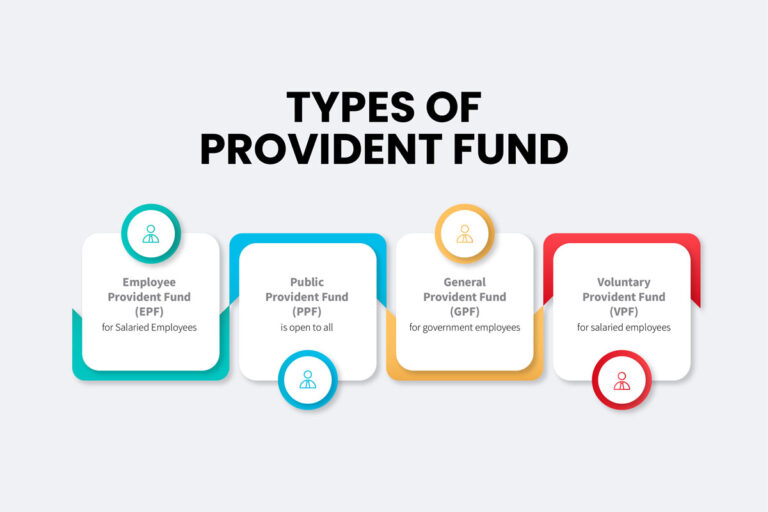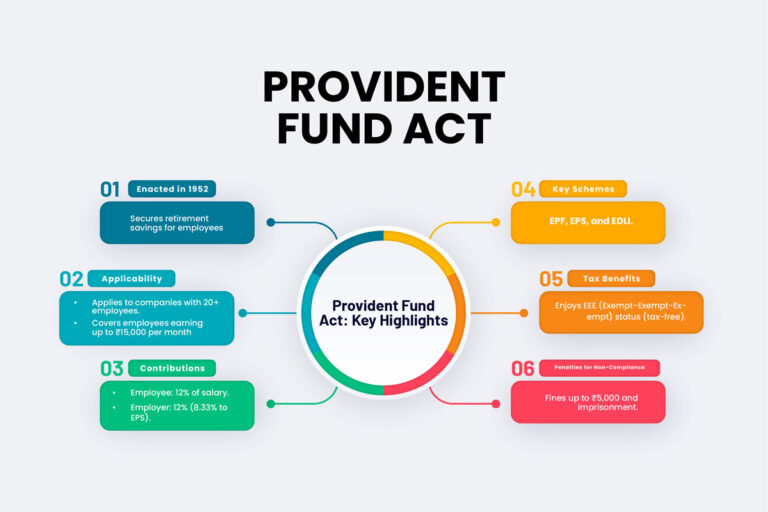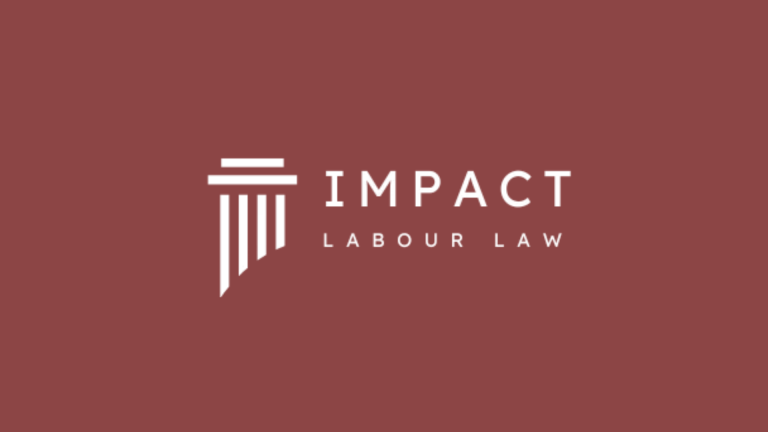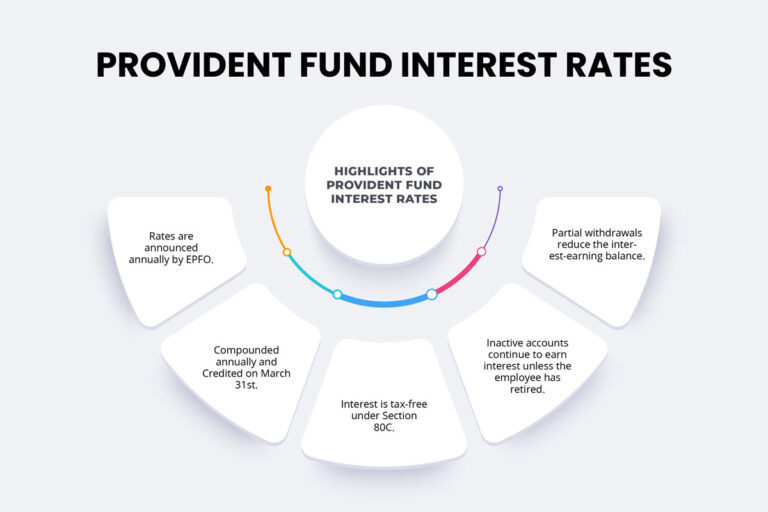The Provident Fund (PF) withdrawal process is a critical aspect of financial planning for employees in India. The Employees’ Provident Fund (EPF) is a retirement savings scheme mandated under the Employees’ Provident Fund and Miscellaneous Provisions Act, 1952, which allows employees to withdraw their accumulated funds under specific circumstances. Understanding the PF withdrawal rules, eligibility criteria, and tax implications is essential for maximising your benefits and avoiding potential pitfalls.
This comprehensive guide will explain the different types of PF withdrawals, the EPF withdrawal process, eligibility conditions, and key tax considerations. We will also walk you through the step-by-step process for provident fund withdrawal online and offline.
Understanding Provident Fund Withdrawal
The EPF withdrawal process is designed to provide financial support to employees at various stages of life, including retirement, unemployment, medical emergencies, and more. Withdrawals can be full or partial, depending on the reason for withdrawal and the employee’s service period.
Common Scenarios for PF Withdrawal:
- Retirement: Employees can withdraw the entire balance upon retirement at the age of 58 years.
- Unemployment: If an employee is unemployed for over two months, the employee can withdraw up to 75% of the balance.
- Medical Emergency: Partial withdrawal is allowed for medical emergencies, including hospitalisation or treatment.
- Home Purchase: Employees can withdraw funds to buy or construct a house.
- Higher Education: Partial withdrawals are permitted for higher education expenses.
Overview of PF Withdrawal Eligibility Criteria:
To be eligible for provident fund withdrawal, an employee must meet certain criteria:
- Age and Service: After retirement, full withdrawal is permitted at the age of 58 years. Partial withdrawals are allowed for specific reasons.
- Unemployment: After one month of unemployment, employees can withdraw 75% of their EPF balance, and after two months of unemployment, the remaining 25% can be withdrawn.
- Medical Needs: Withdrawal is allowed for medical treatment for serious illnesses for oneself or dependents, including spouse, children, and parents.
Types of Provident Fund Withdrawals
1. Partial PF Withdrawal:
Partial withdrawal is allowed for specific purposes, such as:
- Medical Treatment: Up to 6 times the monthly basic wages or the employee’s share, whichever is lower.
- Home Purchase/Construction: Up to 90% of the total EPF balance.
- Higher Education: Up to 50% of the employee’s share for education fees.
- Conditions for Partial Withdrawal: Withdrawal for home purchase or construction requires at least 5 years of service and an active EPF account.
2. Full PF Withdrawal:
Full withdrawal of the provident fund is permitted in situations below:
- After retiring at the age of 58,
- After being unemployed for more than two months,
- In case of permanent disability or other special circumstances.
The Provident Fund Withdrawal Process
Step-by-Step Guide: Provident Fund Withdrawal Online
1. Log in to the EPFO Portal
- Visit the EPFO portal and log in using your Universal Account Number (UAN) and password.
2. Navigate to the Claim Section
- Under the “Online Services” tab, click on “Claim (Form-31, 19 & 10C).”
3. Select the Withdrawal Type
- Choose the relevant withdrawal type (full, partial, or pension).
4. Submit Your Claim
- Fill in the required details and upload the necessary documents.
- Verify the claim using an OTP sent to your Aadhaar-linked mobile number.
5. Track Claim Status
- You can check the status of your claim on the EPFO portal under the “Track Claim Status” section.
Step-by-Step Guide: Provident Fund Withdrawal Offline
1. Download the Required Form
- Download the appropriate EPF withdrawal form from the EPFO website or collect it from your employer.
2. Fill Out the Form
- Complete the necessary details, including personal information, EPF account number, and reason for withdrawal.
3. Submit to the Employer
- Submit the completed form to your employer for attestation.
4. Employer Submits to EPFO
- The employer will forward the form to the EPFO for processing.
Required Documents for Provident Fund Withdrawal
The following documents are typically required to withdraw your EPF funds:
- UAN (Universal Account Number): Linked to your EPF account.
- Aadhaar Card: For identity verification.
- Bank Account Details: Including a cancelled cheque.
- PAN Card: Required to ensure correct tax deductions.
Forms Used for EPF Withdrawal
When applying for the withdrawal of your Provident Fund (PF) balance, it is essential to understand the different forms used for various types of withdrawals. The three most common forms are Form 19, Form 10C, and Form 31. Each form serves a specific purpose, depending on the type of withdrawal you are applying for, whether full, partial, or pension withdrawal.
Here’s a detailed explanation of each form and how to download, fill, and submit them:
Form 19 (Final Settlement of Provident Fund)
Form 19 is used when an employee wants to withdraw their full EPF balance after leaving an organisation or upon retirement. This form is applicable only if the employee is no longer working and has completely exited the EPF scheme.
Usage:
- Full withdrawal of the Provident Fund balance after resignation, retirement, or termination of employment.
- This can only be used if the employee has completely left the workforce and is not working in an organisation contributing to EPF.
How to Download:
You can download Form 19 from the official EPFO portal:
- Visit the EPFO website.
- Navigate to the “Forms” section under Downloads.
- Click on Form 19 (Final Settlement) to download the form in PDF format.
How to Fill Form 19:
- UAN (Universal Account Number): Enter the UAN linked to your EPF account.
- Personal Details: Fill in your name, father’s/spouse’s name, date of birth, and address as per EPF records.
- Reason for Leaving: Specify whether you are withdrawing due to retirement, resignation, or termination.
- Bank Details: Provide your bank account number and IFSC code (ensure your EPF account is linked with this bank account).
- PAN Details: Enter your PAN number for tax purposes (if your service period is less than 5 years, this will affect taxation).
- Aadhaar Number: This is required for identity verification.
How to Submit:
- If you are applying online, log in to the EPFO portal with your UAN and password, go to the Online Claims Section, and select Form 19.
- Offline Submission: If applying offline, submit the filled and signed Form 19 to your employer, who will attest it and forward it to the EPFO office for processing.
Form 10C (Withdrawal Benefit or Pension Scheme Certificate)
Form 10C is to withdraw the pension amount accumulated under the Employees’ Pension Scheme (EPS). It is applicable when an employee resigns or retires and now wants to withdraw the pension benefits or obtain a scheme certificate to carry forward the pension benefits to the next job.
Usage:
- Pension withdrawal when the employee is not eligible for the full pension (if they have completed at least 6 months but less than 10 years of service).
- Employees with less than 10 years of service can use Form 10C to withdraw their pension contributions.
- Scheme Certificate: if employees wish to transfer their pension to the next employer or withdraw later, they can opt for a Scheme Certificate.
How to Download:
- Visit the EPFO website.
- Go to the Downloads section and select Form 10C for pension withdrawal or scheme certificate.
How to Fill Form 10C:
- UAN: Enter the UAN linked to your EPF account.
- Personal Details: Fill in your name, date of birth, father’s/spouse’s name, and address.
- Date of Exit: Mention the date when you left your previous employer.
- Pension Details: Specify whether you are applying for a withdrawal benefit or a scheme certificate.
- Bank Details: Provide your bank account number and IFSC code (ensure it is the same account linked with your UAN).
- Service Details: Provide details about your employment tenure and the contribution period.
How to Submit:
- For online submission, log in to your EPFO account, navigate to the Online Claims Section, and select Form 10C.
- For offline submission, submit the filled Form 10C to your employer for attestation. They will forward it to the EPFO office for processing.
Form 31 (Partial Withdrawal for Specific Purposes)
Form 31 is used for partial withdrawals from the Provident Fund for specific reasons such as medical emergencies, home purchases, higher education, marriage, or house renovations. This form allows employees to access their funds without closing their EPF account or leaving the job.
Usage:
Partial withdrawal for specific needs such as:
- Medical treatment for self or dependents.
- Home purchase/construction.
- Marriage or education of children.
- House renovation.
This form is used for employees who are still employed but need to withdraw a portion of their EPF for a specific reason.
How to Download:
- You can download Form 31 from the EPFO portal by going to the Downloads section and selecting Form 31.
How to Fill Form 31:
- UAN: Enter your UAN and other personal details.
- Purpose of Withdrawal: Specify the reason for withdrawal (e.g., medical, marriage, higher education, etc.).
- Amount of Withdrawal: Mention the amount you wish to withdraw.
- Service Duration: Mention your length of service with the current employer.
- Bank Account Details: Provide the bank account linked with your EPF account for the withdrawal amount.
How to Submit:
- For online submission, log in to your UAN portal, go to the Claim Section, and select Form 31 for partial withdrawal. Follow the on-screen instructions to submit your claim.
- For offline submission, complete the form and submit it to your employer for attestation. Once attested, the employer will send it to the EPFO office for processing.
Summary Table: Forms Used for EPF Withdrawal
| Form Name | Usage | Download | Key Details | Submission |
| Form 19 | Full PF withdrawal after resignation/retirement | EPFO Portal | Requires UAN, PAN, Aadhaar, and bank details | Online via UAN portal or offline through the employer |
| Form 10C | Pension withdrawal or Scheme Certificate | EPFO Portal | Used for EPS pension or to carry forward pension benefits | Online via UAN portal or offline through the employer |
| Form 31 | Partial withdrawal for specific purposes | EPFO Portal | For medical emergencies, house purchases, education, marriage, etc. | Online via UAN portal or offline through the employer |
Common Mistakes to Avoid During the PF Withdrawal Process
- Incorrect Details: The bank account, PAN, and Aadhaar details should be accurate.
- Incomplete Forms: Double-check that all sections of the withdrawal form are filled out correctly.
- Not Checking the UAN Activation: Ensure your UAN is activated and linked to your Aadhaar.
Read more: What Are The Key Points Of Compliance Risks?
How to Check PF Withdrawal Status Online
You can easily check your PF withdrawal status online via the EPFO portal:
- Visit the EPFO Portal.
- Go to the “Track Claim Status” section under the “Online Services” tab.
- Enter your UAN and check the current status of your withdrawal application.
Tax Implications of Provident Fund (PF) Withdrawal
Understanding the tax implications of Provident Fund withdrawal is crucial because how and when you withdraw your EPF balance can significantly affect your taxable income. The tax treatment of PF withdrawals depends on the length of your service, the reason for the withdrawal, and whether or not certain conditions are met.
Here’s a simple breakdown of the tax implications of withdrawing your EPF balance:
PF Withdrawal Before 5 Years of Continuous Service
The withdrawal is taxable if you withdraw your Provident Fund balance before completing 5 years of continuous service. The income tax will be applied in the following manner:
- Employee’s Contribution: This is added to your taxable income and taxed according to your applicable income tax slab rate.
- Employer’s Contribution and Interest Earned: The employer’s contribution and the interest earned on the employer’s and employee’s contributions are also added to your total income and taxed based on your income slab.
- Interest on Employee’s Contribution: The interest earned on your contribution will be taxed under “Income from Other Sources.”
Additionally, if the total withdrawal amount exceeds INR 50,000, the Tax Deducted at Source (TDS) will be applicable:
- TDS Rate: A TDS of 10% is deducted if you have provided your PAN.
- If you do not provide your PAN, TDS will be deducted at 608%. This is a significant deduction, so submit your PAN while making a withdrawal request to avoid it.
Important Note: Even if TDS is not deducted or you don’t cross the INR 50,000 threshold, you still have to report the withdrawal amount in your income tax return and pay the necessary Tax if applicable.
PF Withdrawal After 5 Years of Continuous Service
The withdrawal is tax-exempt if you withdraw your Provident Fund after 5 years of continuous service. This means:
- Both employee and employer contributions, along with the interest earned, are not taxable.
- No TDS is deducted; you do not need to report this amount as income in your income tax return.
Exception to the 5-Year Rule:
If you switch jobs and transfer your EPF balancefrom your old employer to your new employer’s EPF account, the tenure with both employers is combined. This means the 5-year Rule counts your total years of service across jobs as long as you don’t withdraw your PF between jobs.
PF Withdrawal for Special Conditions (Tax Exempt)
In certain exceptional situations, Provident Fund withdrawals are exempt from Tax even if you have not completed 5 years of service. These conditions include:
- Medical Emergencies: Withdrawals for medical treatment due to severe illnesses such as cancer, heart disease, or other life-threatening conditions for yourself or dependents are tax-free.
- Permanent Disability: If you are withdrawing due to a permanent and total disability that makes you unable to continue working, the withdrawal amount is fully tax-exempt.
- Death of the Employee: In the unfortunate event of an employee’s death, the entire EPF amount (including employer contribution, employee contribution, and interest) is paid to the nominee and is exempt from Tax.
TDS on Provident Fund Withdrawal
The TDS on PF withdrawals is only applicable in the following cases:
- You withdraw before completing 5 years of continuous service.
- The total withdrawal amount is more than INR 50,000.
TDS Rates:
- 10% if the PAN is submitted.
- 608% if PAN is not submitted.
Impact of PF Withdrawal on Income Tax Returns
If you withdraw your provident fund before completing 5 years of service, the amount will be added to your gross income and taxed according to your applicable income tax slab. However, any TDS deducted will be adjusted in your income tax returns.
Exempt-Exempt-Exempt (EEE) Status of Provident Fund
The Provident Fund typically enjoys what is known as EEE (Exempt-Exempt-Exempt) status when certain conditions are met:
- Exempt on Contributions: Contributions made by the employee to the PF are exempt from Tax under Section 80C of the Income Tax Act (up to INR 1.5 lakh).
- Exempt on Interest: Interest earned on the Provident Fund is also tax-exempt, provided the withdrawal is made after 5 years of continuous service.
- Exempt on Withdrawal: The final amount withdrawn (after 5 years of service or for special reasons) is also exempt from taxation.
Summary Table: Tax Implications of Provident Fund Withdrawal
| Scenario | Taxability | TDS Applicability |
| Withdrawal before 5 years of service | Taxable | 10% TDS if PAN provided, 34.608% if PAN not provided |
| Withdrawal after 5 years of service | Tax-Exempt | No TDS |
| Withdrawal due to medical emergencies | Tax-Exempt | No TDS |
| Withdrawal due to permanent disability | Tax-Exempt | No TDS |
| Withdrawal on account of death (nominee) | Tax-Exempt | No TDS |
The tax implications of Provident Fund withdrawal largely depend on the timing of your withdrawal and the reason for it. To maximise your financial benefits, plan your withdrawals carefully and consider the tax consequences. Withdrawals after 5 years of continuous service are tax-free, whereas withdrawals before 5 years may incur significant tax liabilities, mainly if PAN is not submitted.
Important Note: From July 2020, withdrawals from small saving schemes can now be subject to TDS (Tax Deducted at Source) under section 194N. Under the new rule, TDS between 2% and 5% applies to withdrawals exceeding Rs. 20 lakh from small savings schemes. However, this TDS is applicable only if the scheme’s subscriber has not filed an income tax return in the past 3 years.
Conclusion
Provident Fund withdrawal is an essential aspect of personal financial planning. Understanding PF withdrawal’s rules, eligibility criteria, and tax implications can help you make informed decisions and optimise your financial benefits. Whether you are planning a withdrawal due to retirement, a medical emergency, or purchasing a home, following the correct process will ensure smooth and timely access to your funds.
Frequently Asked Questions (FAQs)

Article by
Editorial Staff
Impact Labour Law editorial staff is a team comprised of individual writers with strong background in statutory & labour law compliance. Backed by several years of experience, our content creators aim to bring you the best knowledge and learnings related to PF, ESI, POSH Compliance, HR & Payroll management, FSSAI & more.






